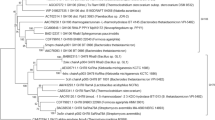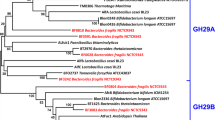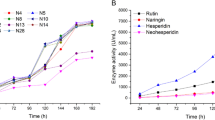Abstract
A putative glycoside hydrolase family 78 α-l-rhamnosidase BtRha78A from Bacteroides thetaiotaomicron VPI-5482 was heterologously over-expressed in Escherichia coli. Enzymatic properties of recombinant BtRha78A were characterized in detail. Recombinant BtRha78A might efficiently hydrolyze p-nitrophenyl α-l-rhamnopyranoside. BtRha78A displayed the highest activity at 60 °C in pH 6.5. BtRha78A exhibited a good pH stability and relatively high thermostability. BtRha78A could be tolerant of a low concentration of alcohols. These attractive advantages made it a promising alternative biocatalyst for industrial applications. The catalytic general acid Asp335 and general base Glu595 of BtRha78A were confirmed by site-directed mutagenesis. Alanine scanning mutagenesis based on sequence alignment and structural analysis revealed that the conserved residues Asp330, Arg334, Trp339, Asp342, Tyr383, Trp440, and His620 were crucial for enzyme catalysis. Most functional residues located at the conserved general acid motif (Asp330–Asp342) and were completely conserved in the subfamily I Rha78s.






Similar content being viewed by others
References
Alvarenga AE, Romero CM, Castro GR (2013) A novel α-l-rhamnosidase with potential applications in citrus juice industry and in winemaking. Eur Food Res Technol 237:977–985
Avila M, Jaquet M, Moine D, Requena T, Peláez C, Arigoni F, Jankovic I (2009) Physiological and biochemical characterization of the two α-l-rhamnosidases of Lactobacillus plantarum NCC245. Microbiology 155:2739–2749
Bang SH, Hyun YJ, Shim J, Hong SW, Kim DH (2015) Metabolism of rutin and poncirin by human intestinal microbiota and cloning of their metabolizing α-l-rhamnosidase from Bifidobacterium dentium. J Microbiol Biotechnol 25:18–25
Beekwilder J, Marcozzi D, Vecchi S, de Vos R, Janssen P, Francke C, van Hylckama Vlieg J, Hall RD (2009) Characterization of rhamnosidases from Lactobacillus plantarum and Lactobacillus acidophilus. Appl Environ Microb 75:3447–3454
Birgisson H, Hreggvidsson GO, Fridjónsson OH, Mort A, Kristjánsson JK, Mattiasson B (2004) Two new thermostable α-l-rhamnosidases from a novel thermophilic bacterium. Enzyme Microb Tech 34:561–571
Bjursell MK, Martens EC, Gordon JI (2006) Functional genomic and metabolic studies of the adaptations of a prominent adult human gut symbiont, Bacteroides thetaiotaomicron, to the suckling period. J Biol Chem 281:36269–36279
Bonanno JB, Almo SC, Bresnick A, Chance MR, Fiser A, Swaminathan S, Jiang J, Studier FW, Shapiro L, Lima CD, Gaasterland TM, Sali A, Bain K, Feil I, Gao X, Lorimer D, Ramos A, Sauder JM, Wasserman SR, Emtage S, D’Amico KL, Burley SK (2005) New York-structural GenomiX research consortium (NYSGXRC): a large scale center for the protein structure initiative. J Struct Funct Genomics 6:225–232
Cui Z, Maruyama Y, Mikami B, Hashimoto W, Murata K (2007) Crystal structure of glycoside hydrolase family 78 α-l-rhamnosidase from Bacillus sp. GL1. J Mol Biol 374:384–398
Cuskin F, Lowe EC, Temple MJ, Zhu Y, Cameron EA, Pudlo NA, Porter NT, Urs K, Thompson AJ, Cartmell A, Rogowski A, Hamilton BS, Chen R, Tolbert TJ, Piens K, Bracke D, Vervecken W, Hakki Z, Speciale G, Munōz-Munōz JL, Day A, Peña MJ, McLean R, Suits MD, Boraston AB, Atherly T, Ziemer CJ, Williams SJ, Davies GJ, Abbott DW, Martens EC, Gilbert HJ (2015) Human gut Bacteroidetes can utilize yeast mannan through a selfish mechanism. Nature 517:165–169
da Silva C, Contesini F, Sawaya A, Cabral E, da Silva Cunha I, Eberlin M, de Oliveira Carvalho P (2013) Enhancement of the antioxidant activity of orange and lime juices by flavonoid enzymatic de-glycosylation. Food Res Int 52:308–314
de Araújo ME, Moreira Franco YE, Alberto TG, Sobreiro MA, Conrado MA, Priolli DG, Frankland Sawaya AC, Ruiz AL, de Carvalho JE, de Oliveira Carvalho P (2013) Enzymatic de-glycosylation of rutin improves its antioxidant and antiproliferative activities. Food Chem 141:266–273
De Winter K, Šimčíková D, Schalck B, Weignerová L, Pelantova H, Soetaert W, Desmet T, Křen V (2013) Chemoenzymatic synthesis of α-l-rhamnosides using recombinant α-l-rhamnosidase from Aspergillus terreus. Bioresour Technol 147:640–644
Dongowski G, Lorenz A, Anger H (2000) Degradation of pectins with different degrees of esterification by Bacteroides thetaiotaomicron isolated from human gut flora. Appl Environ Microbiol 66:1321–1327
Fujimoto Z, Jackson A, Michikawa M, Maehara T, Momma M, Henrissat B, Gilbert HJ, Kaneko S (2013) The structure of a Streptomyces avermitilis α-l-rhamnosidase reveals a novel carbohydrate-binding module CBM67 within the six-domain arrangement. J Biol Chem 288:12376–12385
González-Barrio R, Trindade LM, Manzanares P, de Graaff LH, Tomás-Barberán FA, Espín JC (2004) Production of bioavailable flavonoid glucosides in fruit juices and green tea by use of fungal alpha-l-rhamnosidases. J Agric Food Chem 52:6136–6142
Hashimoto W, Miyake O, Nankai H, Murata K (2003) Molecular identification of an α-l-rhamnosidase from Bacillus sp. strain GL1 as an enzyme involved in complete metabolism of gellan. Arch Biochem Biophys 415:235–244
Ichinose H, Fujimoto Z, Kaneko S (2013) Characterization of an α-l-rhamnosidase from Streptomyces avermitilis. Biosci Biotechnol Biochem 77:213–216
Koropatkin NM, Martens EC, Gordon JI, Smith TJ (2008) Starch catabolism by a prominent human gut symbiont is directed by the recognition of amylose helices. Structure 16:1105–1115
Kumar S, Stecher G, Tamura K (2016) MEGA7: molecular evolutionary genetics analysis version 7.0 for bigger datasets. Mol Biol Evol 33:1870–1874
Lee YS, Huh JY, Nam SH, Moon SK, Lee SB (2012) Enzymatic bioconversion of citrus hesperidin by Aspergillus sojae naringinase: enhanced solubility of hesperetin-7-O-glucoside with in vitro inhibition of human intestinal maltase, HMG-CoA reductase, and growth of Helicobacter pylori. Food Chem 135:2253–2259
Lee YS, Huh JY, Nam SH, Kim D, Lee SB (2013) Synthesis of quercetin-3-O-glucoside from rutin by Penicillium decumbens naringinase. J Food Sci 78:C411–C415
Lombard V, Golaconda Ramulu H, Drula E, Coutinho PM, Henrissat B (2014) The carbohydrate-active enzymes database (CAZy) in 2013. Nucleic Acids Res 42:D490–D495
Lu L, Liu Q, Jin L, Yin Z, Li X, Xiao M (2015) Enzymatic synthesis of rhamnose containing chemicals by reverse hydrolysis. PLoS ONE 10:e0140531
Martens EC, Chiang HC, Gordon JI (2008) Mucosal glycan foraging enhances fitness and transmission of a saccharolytic human gut bacterial symbiont. Cell Host Microbe 4:447–457
Martens EC, Koropatkin NM, Smith TJ, Gordon JI (2009) Complex glycan catabolism by the human gut microbiota: the Bacteroidetes Sus-like paradigm. J Biol Chem 284:24673–24677
Martens EC, Lowe EC, Chiang H, Pudlo NA, Wu M, McNulty NP, Abbott DW, Henrissat B, Gilbert HJ, Bolam DN, Gordon JI (2011) Recognition and degradation of plant cell wall polysaccharides by two human gut symbionts. PLoS Biol 9:e1001221
Mccarter JD, Withers SG (1994) Mechanisms of enzymatic glycoside hydrolysis. Curr Opin Struct Biol 4:885–892
Michlmayr H, Brandes W, Eder R, Schümann C, del Hierro AM, Kulbe KD (2011) Characterization of two distinct glycosyl hydrolase family 78 α-l-rhamnosidases from Pediococcus acidilactici. Appl Environ Microbiol 77:6524–6530
Morrison KL, Weiss GA (2001) Combinatorial alanine-scanning. Curr Opin Chem Biol 5:302–307
Ndeh D, Rogowski A, Cartmell A, Luis AS, Baslé A, Gray J, Venditto I, Briggs J, Zhang X, Labourel A, Terrapon N, Buffetto F, Nepogodiev S, Xiao Y, Field RA, Zhu Y, O’Neill MA, Urbanowicz BR, York WS, Davies GJ, Abbott DW, Ralet MC, Martens EC, Henrissat B, Gilbert HJ (2017) Complex pectin metabolism by gut bacteria reveals novel catalytic functions. Nature 544:65–70
O’Neill EC, Stevenson CE, Paterson MJ, Rejzek M, Chauvin AL, Lawson DM, Field RA (2015) Crystal structure of a novel two domain GH78 family α-rhamnosidase from Klebsiella oxytoca with rhamnose bound. Proteins 83:1742–1749
Rabausch U, Ilmberger N, Streit WR (2014) The metagenome-derived enzyme RhaB opens a new subclass of bacterial B type α-l-rhamnosidases. J Biotechnol 191:38–45
Robert X, Gouet P (2014) Deciphering key features in protein structures with the new ENDscript server. Nucleic Acids Res 42:W320–W324
Salyers AA, Vercellotti JR, West SE, Wilkins TD (1977) Fermentation of mucin and plant polysaccharides by strains of Bacteroides from the human colon. Appl Environ Microbiol 33:319–322
Terrapon N, Lombard V, Gilbert HJ, Henrissat B (2015) Automatic prediction of polysaccharide utilization loci in Bacteroidetes species. Bioinformatics 31:647–655
van Bueren LA, Saraf A, Martens EC, Dijkhuizen L (2015) Differential metabolism of exopolysaccharides from probiotic Lactobacilli by the human gut symbiont Bacteroides thetaiotaomicron. Appl Environ Microbiol 81:3973–3983
Wang W, Malcolm BA (1999) Two-stage PCR protocol allowing introduction of multiple mutations, deletions and insertions using QuikChange site-directed mutagenesis. Biotechniques 26:680–682
Wang J, Ma YL, Wu XY, Yu L, Xia R, Sun GX, Wu FA (2012) Selective hydrolysis by commercially available hesperidinase for isoquercitrin production. J Mol Catal B-Enzym 81:37–42
Weignerová L, Marhol P, Gerstorferová D, Křen V (2012) Preparatory production of quercetin-3-β-d-glucopyranoside using alkali-tolerant thermostable α-l-rhamnosidase from Aspergillus terreus. Bioresour Technol 115:222–227
Xu J, Gordon JI (2003) Honor thy symbionts. Proc Natl Acad Sci USA 100:10452–10459
Xu J, Bjursell MK, Himrod J, Deng S, Carmichael LK, Chiang HC, Hooper LV, Gordon JI (2003) A genomic view of the human-Bacteroides thetaiotaomicron symbiosis. Science 299:2074–2076
Yadav V, Yadav P, Yadav S, Yadav K (2010) alpha-l-Rhamnosidase: a review. Process Biochem 45:1226–1235
You HJ, Ahn HJ, Ji GE (2010) Transformation of rutin to antiproliferative quercetin-3-glucoside by Aspergillus niger. J Agric Food Chem 58:10886–10892
Yu H, Liu H, Zhang C, Tan D, Lu M, Jin F (2004) Purification and characterization of gypenoside-α-l-rhamnosidase hydrolyzing gypenoside-5 into ginsenoside Rd. Process Biochem 39:861–867
Zhang R, Zhang BL, Xie T, Li GC, Yi T, Xiang YT (2015) Biotransformation of rutin to isoquercitrin using recombinant α-l-rhamnosidase from Bifidobacterium breve. Biotechnol Lett 37:1257–1264
Zhu Y, Suits MD, Thompson AJ, Chavan S, Dinev Z, Dumon C, Smith N, Moremen KW, Xiang Y, Siriwardena A, Williams SJ, Gilbert HJ, Davies GJ (2010) Mechanistic insights into a Ca2+-dependent family of alpha-mannosidases in a human gut symbiont. Nat Chem Biol 6:125–132
Zverlov VV, Hertel C, Bronnenmeier K, Hroch A, Kellermann J, Schwarz WH (2000) The thermostable α-l-rhamnosidase RamA of Clostridium stercorarium: biochemical characterization and primary structure of a bacterial α-l-rhamnoside hydrolase, a new type of inverting glycoside hydrolase. Mol Microbiol 35:173–179
Acknowledgements
This work was supported by the National Natural Science Foundation of China (No. 31400684), Natural Science Foundation of Shanxi (No. 2014021030-3), and Scientific Research Foundation for Talent Construction in Shanxi University (No. 206533801001).
Author information
Authors and Affiliations
Corresponding author
Ethics declarations
Conflict of interest
The authors declare that they have no conflict of interest.
Electronic supplementary material
Below is the link to the electronic supplementary material.
Rights and permissions
About this article
Cite this article
Li, B., Ji, Y., Li, Y. et al. Characterization of a glycoside hydrolase family 78 α-l-rhamnosidase from Bacteroides thetaiotaomicron VPI-5482 and identification of functional residues. 3 Biotech 8, 120 (2018). https://doi.org/10.1007/s13205-018-1139-9
Received:
Accepted:
Published:
DOI: https://doi.org/10.1007/s13205-018-1139-9




